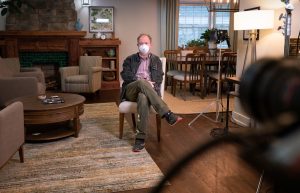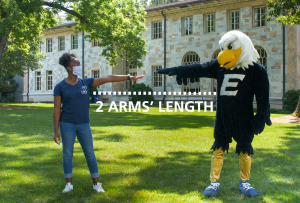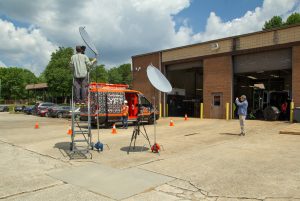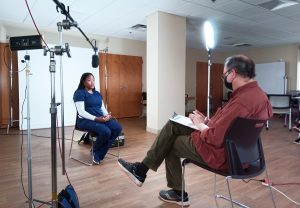 While Covid-19 has slowed much of the world to a crawl, we have been fortunate enough to keep working over the last few months. We help our clients keep communicating by creating new and fresh visual content. There are options for remote productions that yield great work, but sometimes on-location video and photo shoots are still necessary. That’s alright as long as you take the proper safety precautions.
While Covid-19 has slowed much of the world to a crawl, we have been fortunate enough to keep working over the last few months. We help our clients keep communicating by creating new and fresh visual content. There are options for remote productions that yield great work, but sometimes on-location video and photo shoots are still necessary. That’s alright as long as you take the proper safety precautions.We don’t want anyone to get sick, so we take our new practices and procedures very seriously. The notes below are by no means a comprehensive resource for how to stay safe on set, but are some of the questions we ask after a request for new work comes in.
1. Who HAS to be there? These days, the fewer people on set the better. Social distancing outside is pretty easy, but for those shoots that need to happen indoors, less people equals more space for each individual person. We’ve included links at the end of this blog to other articles that lay out safety protocols in relation to a few different scenarios, but in general and if possible, now is not the time for big; now is the time to streamline and make productions as small and efficient as possible in the name of safety.
 2. When and how can we do a location scout? A scout is more important now than ever. Whether in person, or preferably via photos and satellite maps, knowing what you’re walking into is an absolute must. And if a client does not help in this process and get something to you, do not do the shoot. Do NOT agree to a start time until you know what the situation is. You need to see the area you’ll be shooting in, but you’re also looking for the amount of space everyone will have to spread out. If indoors, you need to see the space you’ll be shooting in. And if everyone involved cannot be in the room determine where they will be. If other client/crew members are not in the room, is the hallway nearby crowded with other people? If it’s a long enough shoot where you’ll be eating lunch or any meal together, where and how will food be distributed and where is easily accessible hand sanitizer and bathrooms for washing hands? Take a cue from the airlines and put together individual snack bags for everyone rather than having communal food that people will congregate around, sharing the same serving utensils.
2. When and how can we do a location scout? A scout is more important now than ever. Whether in person, or preferably via photos and satellite maps, knowing what you’re walking into is an absolute must. And if a client does not help in this process and get something to you, do not do the shoot. Do NOT agree to a start time until you know what the situation is. You need to see the area you’ll be shooting in, but you’re also looking for the amount of space everyone will have to spread out. If indoors, you need to see the space you’ll be shooting in. And if everyone involved cannot be in the room determine where they will be. If other client/crew members are not in the room, is the hallway nearby crowded with other people? If it’s a long enough shoot where you’ll be eating lunch or any meal together, where and how will food be distributed and where is easily accessible hand sanitizer and bathrooms for washing hands? Take a cue from the airlines and put together individual snack bags for everyone rather than having communal food that people will congregate around, sharing the same serving utensils.3. Hand sanitizer and wipes – An absolute must for frequent use by all crew. Don’t bring one tiny bottle of sanitizer and expect that to be enough for a few people. Bring a big bottle, or bring a bunch of small bottles, so everybody can have one. The way to think about how to use hand sanitizer on a shoot is knowing what stuff is in your sphere. What are the things you brought and belong to you and your position? Be hyper-aware throughout the day of OTHER things you touch and use sanitizer or wipes after you touch those other things.
 4. Shooting style – Use longer lenses than you normally would. For instance, if you like to shoot interviews, headshots or portraits with a 50mm lens, choose something in the 75-100mm range. That way the entire camera set up can be a few feet further back than normal and you’re framing will be close to your original vision. We use the basic social distancing rule of trying to stay 6ft. away from our subject as the minimum standard, but if at all possible, stay further away. And opt to shoot outside or in very well ventilated areas as much as possible. You may not have chosen the outdoor maintenance area as a location before, but check it out now, it might work. That’s what we did recently and it worked great.
4. Shooting style – Use longer lenses than you normally would. For instance, if you like to shoot interviews, headshots or portraits with a 50mm lens, choose something in the 75-100mm range. That way the entire camera set up can be a few feet further back than normal and you’re framing will be close to your original vision. We use the basic social distancing rule of trying to stay 6ft. away from our subject as the minimum standard, but if at all possible, stay further away. And opt to shoot outside or in very well ventilated areas as much as possible. You may not have chosen the outdoor maintenance area as a location before, but check it out now, it might work. That’s what we did recently and it worked great.5. Everyone wears a mask – There just isn’t an option to not wear one during a current Mixed Bag Media shoot. We want to see the faces of our friends, cast, crew and clients too, but we’d much rather everyone stay safe and healthy so we’ll be able to enjoy time together…later. One exception for removing a mask is if someone is being interviewed and all crew are at least 6’-10’ from the person being interviewed; that’s ok, but as soon as the interview is done, we ask that your mask be put back on.
 We’ve been able to successfully execute purposely small shoots over the last few months by sticking with the basics. Basic safety rules are not hard. Like so many others, we have adopted new habits and ways of doing things, and so should you (if you haven’t already). We will continue to work on future projects, and as CDC guidelines change, so will we. Our team are fans of the news and keep a close watch on new reports, new ideas and new suggestions relating to Covid-19 and how to keep working. Along with our notes above, please find a few additional resources below that are helpful.
We’ve been able to successfully execute purposely small shoots over the last few months by sticking with the basics. Basic safety rules are not hard. Like so many others, we have adopted new habits and ways of doing things, and so should you (if you haven’t already). We will continue to work on future projects, and as CDC guidelines change, so will we. Our team are fans of the news and keep a close watch on new reports, new ideas and new suggestions relating to Covid-19 and how to keep working. Along with our notes above, please find a few additional resources below that are helpful.Additional Reading:
• How to disinfect your equipment
• Running a safe and healthy photo shoot
• Tips for posing portrait models while socially distanced
• Going Contactless – Photography at a distance
-Jon Milavec